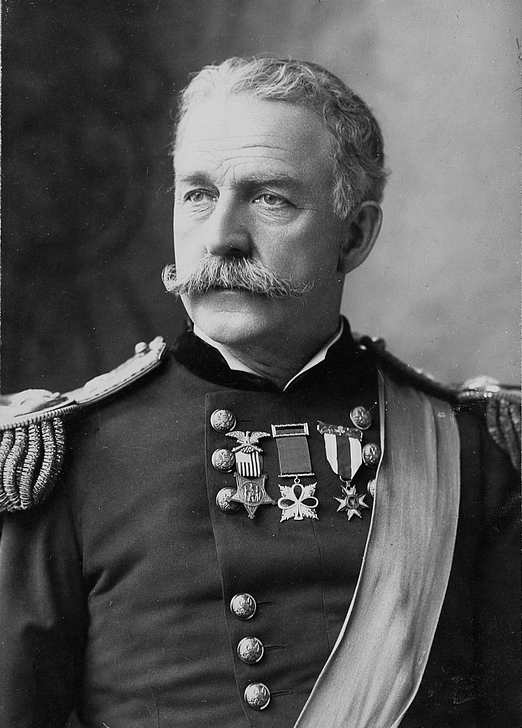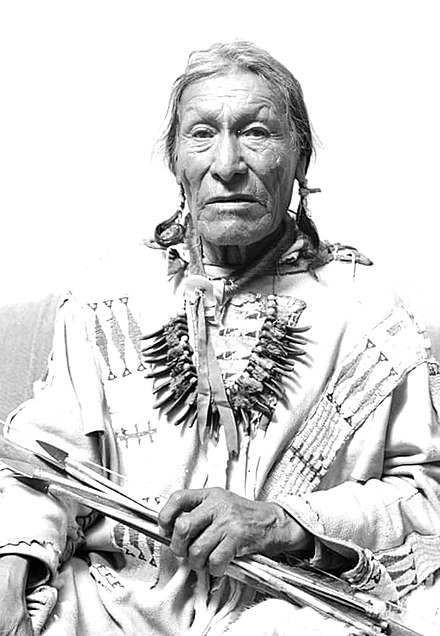Perspectives from Wounded Knee
Primary sources are the raw data of history. Because they are created during the event being studied, they offer un-interpreted, first-person perspectives that are incredibly useful when studying the past. They are also tricky. In order to use primary sources most effectively, historians and history students must approach them with a critical eye. By their nature, primary sources are full of biases that scholars must be aware of to use them appropriately. Primary sources are not important in the study of history because they offer a 100% accurate view of the past (they don’t), but because they provide the first-person perspective of those intimately involved in the event being studied. Multiple sources connected to a single event are often contradictory and must be sorted out by the researcher.
What follows are three accounts of how the Wounded Knee Massacre began. General Miles, who was not at the engagement, but was in-charge of the US Army’s troops who were there, reported the event and was critical of the officers in command. Dewey Beard was a 32-year-old Lakota participant who lost his family and was wounded three times during the event. His account provides a Lakota version of events. And finally, Phillip Wells was an interpreter for the US Army who was part Dakota. His version is an example of the story most of the soldiers told that is at odds with other historical factors.
After having read the preceding narrative, review the biographical sketches and read each of the following accounts. With the background knowledge provided by the narrative and biographical sketches, analyze the three accounts and respond to the questions that follow.
General Nelson A. Miles

“Nelson Appleton Miles ranks among the army’s most effective leaders in the Indian wars of the late nineteenth century. Born at Westminster, Massachusetts, on August 6, 1839, he joined the Union army following the First Battle of Bull Run. Though lacking in formal military training, he proved an excellent combat leader. He participated in all of the Army of the Potomac’s major campaigns except Gettysburg, suffered three wounds, and emerged from the war a brevet-major general. He supervised the imprisonment of former Confederate president Jefferson Davis at Fortress Monroe, Virginia, from May 1864 to August 1865.
In September 1866 Miles became a full colonel in the reorganized post–Civil War regular army. In April 1869, following Reconstruction related duty in North Carolina, he was transferred with the Fifth Infantry Regiment to Kansas. During the next decade Miles commanded troops in a succession of campaigns against Native Americans in the Great Plains–the Red River War (1874–75), the Sioux War (1876–77), and the Nez Perce campaign (1877). He was promoted to brigadier general in 1881 and later helped to organize the capture of Geronimo. After securing a second general’s star, he oversaw the Ghost Dance campaign of 1890–91.”[1]
General Miles was not at the engagement at Wounded Knee, but he was in command of the “Ghost Dance Campaign.” He was very critical of Colonel Forsyth’s actions during what he called a “cold-blooded massacre.”
General Nelson A. Miles
…A detachment of soldiers was sent into the camp to search for any arms remaining there, and it was reported that their rudeness frightened the women and children. It was also reported that a remark was made by one of the soldiers that “when we get the arms away from them we can do as we please with them,” indicating that they were to be destroyed. Some of the Indians could understand English. This and other things alarmed the Indians and [a] scuffle occurred between one warrior who had [a] rifle in his hand and two soldiers. The rifle was discharged and a massacre occurred, not only the warriors but the sick Chief Big Foot, and a large number of women and children who tried to escape by running and scattering over the prairie were hunted down and killed.[2]
Dewey Beard

“Dewey Beard or Wasú Máza (“Iron Hail”, 1858–1955) was a Minneconjou Lakota who fought in the Battle of Little Bighorn as a teenager. After George Armstrong Custer’s defeat, Wasu Maza followed Sitting Bull into exile in Canada and then back to South Dakota where he lived on the Cheyenne River Indian Reservation.
Iron Hail joined the Ghost Dance movement and was in Spotted Elk’s band along with his parents, siblings, wife and child. He and his family left the Cheyenne River Indian Reservation on December 23, 1890 with Spotted Elk and approximately 300 other Miniconjou and 38 Hunkpapa Lakota on a winter trek to the Pine Ridge Indian Reservation to avoid the perceived trouble which was anticipated in the wake of Sitting Bull’s murder at Standing Rock Indian Reservation. He and his family were present at the Wounded Knee Massacre, where he was shot three times, twice in the back and some of his family, including his mother, father, wife and infant child were killed. He recounted his experiences in an in depth interview with Eli S. Ricker for a book Ricker planned to write.”[3]
Dewey Beard, Lakota
…Most of the Indians had given up their arms; there were a few standing with their guns, but the soldiers had not been to them. The knives were piled up in the center of the council; some young men had their guns and knives, but they had not been asked yet for them. There was a deaf Indian named Black Coyote who did not want to give up his gun; he did not understand what they were giving up their arms for… The struggle for the gun was short, the muzzle pointed upward toward the east and the gun was discharged. In an instant a volley followed as one shot, and the people began falling….[4]
Phillip F. Wells
“Philip Faribault Wells was born December 5, 1850 in Minnesota to James and Jane (Graham) Wells, he was one quarter Dakota. A self-educated man, Wells was proficient in several languages including French and Dakota. He was chief guide, interpreter and scout for the United States Army during the Messiah War and was present at Wounded Knee. He interacted with several prominent military and Native American figures in Dakota Territory from the 1870s to 1890s.[5]
Philip F. Wells Interpreter for General Forsyth
…I heard someone on my left exclaim, ‘Look out ! Look out !’ Turning my head and bringing my arms to port, I saw five or six young warriors cast off their blankets and pull guns out from under them and brandish them in the air. One of the warriors shot into the soldiers, who were ordered to fire into the Indians… I heard a shot from the midst of the Indians. As I started to cock my rifle, I looked in the direction of the medicine man. He or some other medicine man approached to within three or four feet of me with a long cheese knife, ground to a sharp point and raised it to stab me. The fight between us prevented my seeing anything else at the time. He stabbed me during the melee and nearly cut off my nose. I held him off until I could swing my rifle to hit him, which I did. I shot and killed him in self-defense and as an act of war as soon as I could gain room to aim my rifle and fire….[6]
Analyzing the Accounts
- Summarize each of the accounts, identify where they are similar and different. How do you account for these differences?
- Using the narrative and biographical sketches as context, use the three sources to construct a one-paragraph description of how the Massacre at Wounded Knee began. Do not quote directly from the secondary sources (the narrative and biographical sketches), but feel free to quote from the primary source accounts.
- Biographical note is quoted from: MILES, NELSON (1839-1925). Encyclopedia of the Great Plains. Available online at: Encyclopedia of the Great Plains | MILES, NELSON (1839-1925) (unl.edu) as of May 8, 2023. ↵
- "Documents Relating to the Wounded Knee Massacre," Digital History available at: Digital History (uh.edu) as of May 8, 2023. ↵
- Biographical note is quoted from: Wikipedia contributors, "Dewey Beard," Wikipedia, The Free Encyclopedia, https://en.wikipedia.org/w/index.php?title=Dewey_Beard&oldid=1140057284 (accessed May 8, 2023). ↵
- Documents Relating to the Wounded Knee Massacre," Digital History available at: Digital History (uh.edu) as of May 8, 2023. ↵
- Biblipographical note is quoted from The Phillip F. Wells Collection, South Dakota State Archives." Available at: Philip F. Wells Collection | South Dakota State Archives ArchivesSpace (lyrasistechnology.org) as of May 8, 2023. Note: I changed the word "Sioux" in the original to "Dakota" ↵
- Documents Relating to the Wounded Knee Massacre," Digital History available at: Digital History (uh.edu) as of May 8, 2023. ↵

